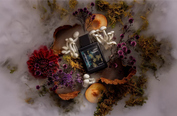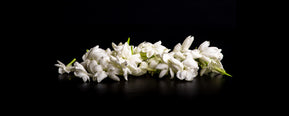Ginger isn’t just a spice found in your kitchen; it’s a star in the world of perfumery and aromatherapy.
With a scent that is instantly recognizable and surprisingly complex, ginger brings warmth, energy, and brightness to any fragrance composition.
In this guide, we’ll explore what ginger smells like, how it’s used in perfume, and why it’s a favorite for modern scent creators.
What is Ginger?
Ginger, or Zingiber officinale, is a flowering plant from the Zingiberaceae family, native to Southeast Asia. The part most commonly used is the rhizome, or underground stem, which has been prized for centuries in culinary, medicinal, and aromatic applications.
Today, ginger is cultivated in tropical and subtropical regions across the globe, including India, China, Indonesia, Nigeria, and Thailand.
India is the largest producer, contributing over 30% of the global supply.
The rhizomes are harvested and either dried or distilled into essential oil, depending on their intended use.
In perfumery, ginger’s fresh spiciness and vibrant warmth make it a versatile ingredient. It carries strong cultural symbolism, associated with vitality, purification, and protective energy, which continues to inspire its modern fragrance use.
What Does Ginger Smell Like?
Ginger has a bold, spicy scent that is as complex as it is invigorating. The aroma is often described as earthy and woody, reflecting its growth underground. It also carries zesty, citrusy top notes and a sharp, peppery heat that wakes up the senses. This fiery edge is balanced by subtle warmth and a slightly sweet nuance, making it both grounding and refreshing.
Ginger essential oil is what’s typically used in perfumery to capture this layered aroma. In addition to its spiciness, many perfumers note its effervescent quality that livens up a fragrance’s opening. It can also be perceived as a gourmand scent, especially when paired with vanilla, orange blossom, or other edible-smelling notes. Gourmand fragrances are those that evoke the sweetness or richness of foods, and ginger’s cozy warmth makes it a natural fit.
Depending on how it’s blended, ginger can emphasize either its green, herbal freshness or its sweeter, almost candied profile.
Ginger in Perfumery
In perfumery, ginger is often used as a top or middle note. It adds an immediate burst of brightness that helps open a fragrance and bring energy from the first spray.
The scent of ginger is lively, fresh, and slightly exotic. It pairs well with citrus, floral, and woody notes, adding contrast and depth to both simple and complex compositions. Its peppery edge lifts the top of the fragrance, while its sweetness and warmth support the heart and base as the scent develops.
Ginger also improves how a perfume performs. Its bright, effusive character helps other fragrance notes project more clearly and feel fuller on the skin.
Variations of Ginger in Perfumery
Ginger’s aromatic profile can vary depending on its form, extraction method, and geographic origin:
- Fresh Ginger: Has a bright, sharp, and zesty aroma with green and citrus notes. Used to create lively, energizing top notes.
- Dried Ginger: Exhibits a deeper, spicier, and slightly smoky character. It’s warmer and more grounded, ideal for adding dimension to amber or gourmand blends.
- Ginger Essential Oil: Typically extracted via steam distillation from dried rhizomes. It retains the spicy, woody warmth and is highly valued for its longevity and sillage.
- Use Carbon Dioxide (CO2) to Extract the Ginger Scent: Pressurized carbon dioxide to capture ginger’s full aromatic range. Combining the zesty brightness of fresh ginger with the warm and spicy depth of dried ginger. This method offers a balanced, true-to-nature expression..
- Synthetic Ginger Compounds: Used for consistency and creative variation, common molecules include gingerol derivatives and zingerone.
The origin of the ginger also affects its aromatic profile. For instance:
- Indian ginger tends to be robust and spicy.
- Chinese ginger has a light herbal scent that feels grounding.
- Nigerian ginger offers a more pungent, peppery profile.
- Madagascar ginger (used in Buchart Colbert’s Knife Thrower) is known for its fresh, zesty scent that carries subtle citrus and woody undertones.
Benefits of Ginger in Aromatherapy
In aromatherapy, people use ginger essential oil to energize the body, improve circulation, and support emotional focus.
- Stimulate circulation: Improves blood flow and reduces coldness in the extremities.
- Relieve nausea: Proven effective in reducing motion sickness and morning sickness, often via inhalation or topical use.
- Ease muscle pain and inflammation: Thanks to compounds like gingerol and shogaol, which have anti-inflammatory effects.
- Enhance mood and clarity: People often use this scent to combat fatigue and stay emotionally focused.
Its bold aroma makes it ideal for invigorating diffuser blends, energizing massage oils, and morning skincare routines.
What Scents Pair Well With Ginger?
When it comes to layering fragrances, it’s essential to choose complementary notes across the top, middle, and base layers. Ginger's spicy and zesty profile makes it highly versatile, blending well with both vibrant and comforting ingredients.
Depending on the story the perfumer wants to tell, or even the season, each combination can shift the mood and feel of a fragrance, adding energy, warmth, or complexity in subtle and surprising ways.
1. Lemon
Lemon and ginger are both bold, energizing aromas. The tangy brightness of lemon cuts through the spice of ginger, resulting in a lively and refreshing blend, perfect for spring and summer scents.
2. Vanilla
Vanilla softens ginger’s edge with creamy sweetness. The result is a comforting, gourmand-like scent that evokes warmth and nostalgia, ideal for fall and winter perfumes.
3. Pink Pepper
Pink pepper adds a fruity, floral dimension that tempers ginger’s heat with a soft rosiness. This pairing creates a modern, slightly sweet scent with a warm, spicy foundation. It's especially suited for transitional seasons like spring and fall, where warmth and vibrancy are both welcome.
Whether your fragrance goal is crisp and uplifting or rich and cozy, ginger’s adaptability allows it to elevate a wide range of scent profiles. Curious how ginger fits into modern formulations? Browse our eau de parfum range for fresh inspiration.
Spice It Up
So, what does ginger smell like? Ginger smells spicy, zesty, and slightly woody, with hints of citrus and warmth. It's invigorating yet smooth, making it a standout note in both energetic and fine perfumes.
At Buchart Colbert, we use ginger with intention, especially in our fragrance Knife Thrower. This scent draws inspiration from precision, poise, and energy. The inclusion of Madagascar ginger as a heart note introduces a crisp, zesty element that bridges citrus, marine, and herbal facets. Paired with grapefruit and softened by melon and coriander on the top, the ginger adds a spark that leads into a cool, grounded base of musk, woods, and fern.
This creates contrast and movement, two key qualities that make Knife Thrower feel dynamic yet fluid. The overall composition is fresh and aquatic, but thanks to ginger, it carries an undercurrent of boldness and drive.
Buchart Colbert is proud to be an indie perfume house known for thoughtful, layered compositions built around ingredients like ginger.
Begin your journey with our Sample Discovery Set, designed to immerse you in our signature scent style. Inside, you’ll find a curated selection of fragrances, plus a $49 credit toward your first full-size bottle.
FAQ
1. How does Madagascar Ginger compare to Indian, Nigerian, and other Gingers in Perfumery?
The geographic origin of ginger profoundly shapes its aromatic profile and influences how it interacts within a fragrance composition.
- Madagascar Ginger: Fresh, lemony, and sparkling. Ideal for mid notes in light, floral, or citrusy scents (e.g., this is how we use it in Knife Thrower to bring a clean, citrus-bright heart to the fragrance, enhancing floral and green notes).
- Indian Ginger: Hot, spicy, and robust. Commonly used in warm, spiced compositions to add depth and heat.
- Nigerian Ginger: Earthy, dry, and rustic. Often used as a base accent in masculine or woody blends for a grounded feel.
2. Does Ginger Smell Sweet or Spicy? Ginger is primarily spicy with zesty citrus notes. It can smell sweet when blended with gourmand or creamy ingredients.


